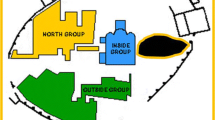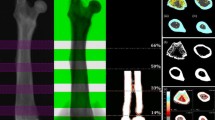Abstract
Pathophysiological conditions can modify the skeletal chemical concentration. This study analyzes the elemental composition in two anatomical regions from dry femoral bone using a portable X-Ray Fluorescence (pXRF) and evaluates its impact in the bone mineral density (BMD). The left femora of 97 female skeletons (21–95 years old individuals) from the Coimbra Identified Skeletal Collection were studied. Diagenetic biases were discarded at the outset and BMD was determined with Dual-energy X-ray absorptiometry. Chemical measurements were performed at the midpoint of the femoral neck and at the midshaft using a pXRF device, and comparisons were made considering the age and the BMD values. Only elements with a Technical Measurement Error ≤ 5% were selected: P, S, Ca, Fe, Zn, As, Sr, Pb and the Ca/P ratio. Statistically significant differences were found between regions, with higher concentrations of P, Ca, Zn and S at the midshaft, and the Ca/P ratio at the femoral neck. The concentration of P is higher in individuals < 50 years, while S and Ca/P ratio increase in individuals ≥ 50 years. The decrease of P with age can be simultaneously related to the decline of its concentration in osteoporosis. Decreased BMD is also associated with higher levels of S and Pb. Osteoporosis enhances the absorption of osteolytic elements in specific locations. This fast and non-destructive technique has proved effective for the comprehension of chemical changes related to bone mass loss. This study highlights the potential of identified skeletal collections to improve the knowledge about bone fragility.

source of emission should be perpendicular, fitting the distance between the device and the bone as minimal to reduce air pollution

Similar content being viewed by others
Data Availability
Available upon request.
Abbreviations
- pXRF:
-
Portable X-Ray Fluorescence
- BMD:
-
Bone mineral density
- rTEM:
-
Relative technical measurement error
- DXA:
-
Dual-energy X-ray absorptiometry
- OP:
-
Osteoporosis
- CSIC:
-
Coimbra Identified Skeletal Collection
- s.d.:
-
Standard deviation
References
NIH Consensus Development Panel on Osteoporosis Prevention Diagnosis and Therapy (2001) Osteoporosis prevention, diagnosis, and therapy. J Am Med Assoc 285:785–795. https://doi.org/10.1001/jama.285.6.785
Svedbom A, Hadji P, Hernlund E et al (2019) Cost-effectiveness of pharmacological fracture prevention for osteoporosis as prescribed in clinical practice in France, Germany, Italy, Spain, and the United Kingdom. Osteoporos Int 30:1745–1754. https://doi.org/10.1007/s00198-019-05064-w
Osterhoff G, Morgan EF, Shefelbine SJ et al (2016) Bone mechanical properties and changes with osteoporosis. Injury 47:S11–S20. https://doi.org/10.1016/S0020-1383(16)47003-8
Greenwood C, Clement J, Dicken A et al (2018) Age-related changes in femoral head trabecular microarchitecture. Aging Dis 9:976–987. https://doi.org/10.14336/AD.2018.0124
Ratnayake JTB, Mucalo M, Dias GJ (2017) Substituted hydroxyapatites for bone regeneration: a review of current trends. J Biomed Mater Res B 105:1285–1299. https://doi.org/10.1002/jbm.b.33651
Bronner F (2002) Metals in bone: aluminum, boron, cadmium, chromium, lead, silicon, and strontium. In: Bilezikian JP, Raisz LG, Rodan GA (eds) Principles of bone biology, 2nd edn. Academic Press, Elsevier, pp 359–369
Zaichick S, Zaichick V (2010) The effect of age and gender on 38 chemical element contents in human iliac crest investigated by instrumental neutron activation analysis. J Trace Elem Med Biol 24:1–6. https://doi.org/10.1016/j.jtemb.2009.07.002
Specht AJ, Weisskopf M, Nie LH (2014) Portable XRF technology to quantify Pb in bone in vivo. J Biomarkers 2014:1–9. https://doi.org/10.1155/2014/398032
Nganvongpanit K, Buddhachat K, Brown JL (2016) Comparison of bone tissue elements between normal and osteoarthritic pelvic bones in dogs. Biol Trace Elem Res 171:344–353. https://doi.org/10.1007/s12011-015-0556-4
Noor Z, Sumitro SB, Hidayat M et al (2012) Atomic mineral characteristics of Indonesian osteoporosis by high-resolution inductively coupled plasma mass spectrometry. Sci World J 1:6. https://doi.org/10.1100/2012/372972
Santos C, Fonseca M, Corregidor V et al (2014) Elemental distribution in human femoral head. Nucl Instrum Methods Phys Res B 331:266–270. https://doi.org/10.1016/j.nimb.2014.01.032
Nganvongpanit K, Buddhachat K, Klinhom S et al (2016) Determining comparative elemental profile using handheld X-ray fluorescence in humans, elephants, dogs, and dolphins: preliminary study for species identification. Forensic Sci Int 263:101–106. https://doi.org/10.1016/j.forsciint.2016.03.056
Zaichick V (2006) INAA of Ca, Cl, K, Mg, Mn, Na, P, and Sr contents in the human cortical and trabecular bone. J Radioanal Nucl Chem 269:653–659. https://doi.org/10.1007/s10967-006-0281-8
Brätter P, Gawlik D, Lausch J, Rösick U (1977) On the distribution of trace elements in human skeletons. J Radioanal Chem 37:393–403. https://doi.org/10.1007/BF02520545
Kuo HW, Kuo SM, Chou CH, Lee TC (2000) Determination of 14 elements in Taiwanese bones. Sci Total Environ 255:45–54. https://doi.org/10.1016/S0048-9697(00)00448-4
Zaichick V (2013) Data for the reference man: skeleton content of chemical elements. Radiat Environ Biophys 52:65–85. https://doi.org/10.1007/s00411-012-0448-3
Mahanti HS, Barnes RM (1983) Determination of major, minor and trace elements in bone by inductively-coupled plasma emission spectrometry. Anal Chim Acta 151:409–417. https://doi.org/10.1016/S0003-2670(00)80103-8
Tranquilli AL, Lucino E, Garzetti GG, Romanini C (1994) Calcium, phosphorus and magnesium intakes correlate with bone mineral content in postmenopausal women. Gynecol Endocrinol 8:55–58. https://doi.org/10.3109/09513599409028459
Chotiyarnwong P, McCloskey EV (2020) Pathogenesis of glucocorticoid-induced osteoporosis and options for treatment. Nat Rev Endocrinol 16:437–447. https://doi.org/10.1038/s41574-020-0341-0
Dick IM, Prince RL (2001) The effect of estrogen on renal phosphorus handling in the rat. Am J Nephrol 21:323–330. https://doi.org/10.1159/000046269
Shen G, Zhang Y, Hu S et al (2017) Adult-onset hypophosphatemic osteomalacia associated with Sjogren syndrome: clinical case report. Medicine (United States) 96:e6493. https://doi.org/10.1097/MD.0000000000006493
Cunha E, Wasterlain S (2007) The Coimbra identified osteological collections. In: Grupe G, Peters J (eds) Skeletal Series in their Socioeconomic Context. M. Leidorf, Rahden/Westf., pp 23–33
Navega D, Coelho J, d. O, Cunha E, Curate F (2018) DXAGE: a new method for age at death estimation based on femoral bone mineral density and artificial neural networks. J Forensic Sci 63:497–503. https://doi.org/10.1111/1556-4029.13582
Bergot C, Wu Y, Jolivet E et al (2009) The degree and distribution of cortical bone mineralization in the human femoral shaft change with age and sex in a microradiographic study. Bone 45:435–442. https://doi.org/10.1016/j.bone.2009.05.025
Curate JFT, Albuquerque A, Correia J et al (2013) A glimpse from the past: osteoporosis and osteoporotic fractures in a portuguese identified skeletal sample. Acta Reumatol Port 38:20–27
Organization WH (1994) Assessment of fracture risk and its application to screening for postmenopausal osteoporosis: report of a WHO study group [meeting held in Rome from 22 to 25 June 1992]
Catarino L, Gil FPSC, Quinta-Ferreira M, Marques F (2018) Characterization and rehabilitation of the “Porta Férrea” stone materials, University of Coimbra, Portugal. Environ Earth Sci 77:416–429. https://doi.org/10.1007/s12665-018-7587-z
Fahy GE, Deter C, Pitfield R et al (2017) Bone deep: variation in stable isotope ratios and histomorphometric measurements of bone remodelling within adult humans. J Archaeol Sci 87:10–16. https://doi.org/10.1016/j.jas.2017.09.009
Byrnes JF, Bush PJ (2016) Practical considerations in trace element analysis of bone by portable X-ray fluorescence. J Forensic Sci 61:1041–1045. https://doi.org/10.1111/1556-4029.13103
Pemmer B, Roschger A, Wastl A et al (2013) Spatial distribution of the trace elements zinc, strontium and lead in human bone tissue. Bone 57:184–193. https://doi.org/10.1016/j.bone.2013.07.038
Grupe G (1988) Impact of the choice of bone samples on trace element data in excavated human skeletons. J Archaeol Sci 15:123–129. https://doi.org/10.1016/0305-4403(88)90002-7
Dermience M, Lognay G, Mathieu F, Goyens P (2015) Effects of thirty elements on bone metabolism. J Trace Elem Med Biol 32:86–106. https://doi.org/10.1016/j.jtemb.2015.06.005
Soni G, Kaur Kochar G, Gurpreet K (2018) Beneficial effect of calcium supplementation on bone mineral density of calcium deficient adolescents. Int J Food Sci Biotechnol 3:83–88. https://doi.org/10.11648/j.ijfsb.20180303.12
Rockell JEP, Williams SM, Taylor RW et al (2005) Two-year changes in bone and body composition in young children with a history of prolonged milk avoidance. Osteoporos Int 16:1016–1023. https://doi.org/10.1007/s00198-004-1789-9
Mahdi AA, Brown RB, Razzaque MS (2015) Osteoporosis in populations with high calcium intake: does phosphate toxicity explain the paradox? Indian J Clin Biochem 30:365–367. https://doi.org/10.1007/s12291-015-0524-y
Calvo MS (1993) Dietary phosphorus, calcium metabolism and bone. J Nutr 123:1627–1633. https://doi.org/10.1093/jn/123.9.1627
Renkema KY, Alexander RT, Bindels RJ, Hoenderop JG (2008) Calcium and phosphate homeostasis: concerted interplay of new regulators. Ann Med 40:82–91. https://doi.org/10.1080/07853890701689645
Krishnarao GVG, Draper HH (1972) Influence of dietary phosphate on bone resorption in senescent mice. J Nutr 102:1143–1145. https://doi.org/10.1093/jn/102.9.1143
Kourkoumelis N, Balatsoukas I, Tzaphlidou M (2012) Ca/P concentration ratio at different sites of normal and osteoporotic rabbit bones evaluated by Auger and energy dispersive X-ray spectroscopy. J Biol Phys 38:279–291. https://doi.org/10.1007/s10867-011-9247-3
Zaichick V, Tzaphlidou M (2003) Calcium and phosphorus concentrations and the calcium/phosphorus ratio in trabecular bone from the femoral neck of healthy humans as determined by neutron activation analysis. Appl Radiat Isot 58:623–627. https://doi.org/10.1016/S0969-8043(03)00092-7
Tzaphlidou M (2008) Bone architecture: collagen structure and calcium/phosphorus maps. J Biol Phys 34:39–49. https://doi.org/10.1007/s10867-008-9115-y
Al-Timimi D, Al-Dabbagh S, Al-Timimi DJ et al (2017) Zinc status as a risk of osteoporosis. Int J Pharma Res Heal Sci 5:1686–1689. https://doi.org/10.21276/ijprhs.2017.02.16
Potula V, Kaye W (2006) The impact of menopause and lifestyle factors on blood and bone lead levels among female former smelter workers: The Bunker Hill Study. Am J Ind Med 49:143–152. https://doi.org/10.1002/ajim.20262
Crawford MD, Crawford T (1969) Lead content of bones in a soft and a hard water area. Lancet 293:699–701. https://doi.org/10.1016/S0140-6736(69)92649-X
Thorpe M, Mojtahedi MC, Chapman-Novakofski K et al (2008) A positive association of lumbar spine bone mineral density with dietary protein is suppressed by a negative association with protein sulfur. J Nutr 138:80–85. https://doi.org/10.1093/jn/138.1.80
Acknowledgements
This study was supported by the ERASMUS+ internship [SZ] performed in the Research Centre for Anthropology and Health (CIAS: PEstOE/SADG/UI0283/2020) at the University of Coimbra and the FCT-Fellowship SFRH/BD/115691/2016 [AMC]. The authors express their gratitude to the Department of Life Sciences and to Sofia Wasterlain for authorizing the study of the identified skeletal collection, to the Department of Earth Sciences, Geosciences Center (CGeo) for the use of the pXRF device, and to Carlos Martínez-Toledano for the achievement of the illustrations. The authors also acknowledge the editorial board members and the two anonymous reviewers who improved the content of this paper through their suggestions and comments.
Funding
FCT-Fellowship SFRH/BD/115691/2016 [AMC], Erasmus + Program [SZ].
Author information
Authors and Affiliations
Contributions
SZ, AMC and ALS designed research and analyzed data. LC and FC performed research and analyzed data. SZ and AMC wrote the manuscript and SZ, AMC, LC, FC and ALS edited the manuscript.
Corresponding author
Ethics declarations
Conflict of interest
Sofía Zdral, Álvaro M. Monge Calleja, Lidia Catarino, Francisco Curate, and Ana Luisa Santos declare that they have no conflict of interest.
Ethical Approval
Not applicable.
Informed Consent
Not applicable.
Additional information
Publisher's Note
Springer Nature remains neutral with regard to jurisdictional claims in published maps and institutional affiliations.
Rights and permissions
About this article
Cite this article
Zdral, S., Monge Calleja, Á.M., Catarino, L. et al. Elemental Composition in Female Dry Femora Using Portable X-Ray Fluorescence (pXRF): Association with Age and Osteoporosis. Calcif Tissue Int 109, 231–240 (2021). https://doi.org/10.1007/s00223-021-00840-5
Received:
Accepted:
Published:
Issue Date:
DOI: https://doi.org/10.1007/s00223-021-00840-5




